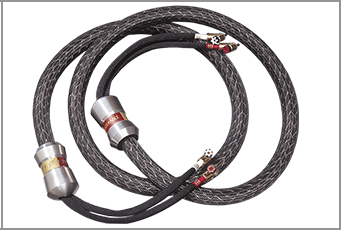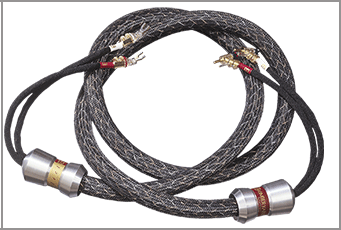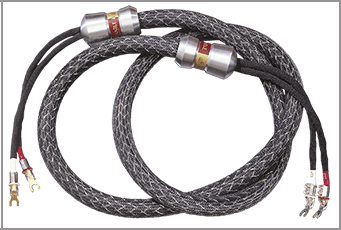You are reading the older HTML site
Positive Feedback
ISSUE
22
kimber kable
KS 3038, KS 3033, and KS 3035 loudspeaker cables
as reviewed by Karl Lozier

Kimber KS 3033
KARL LOZIER'S SYSTEM
LOUDSPEAKERS
ELECTRONICS
SOURCES
CABLES
ACCESSORIES
|
Being the fastest metal conductor of electricity, silver is often the starting point for experiments or designers. "Hopefully, everyone should be searching for the most accurate transfer of the audio signal from one component to another" mused PFO editor Dave Clark recently. That seemingly simple comment got me thinking. I mentioned that to Dick Diamond, Kimber Kable's Director of Sales, Marketing and PR. Kimber Kable still enjoys the reputation of having the largest and best audio cable research department in the world. He responded that they could backup that statement and also objectively prove that high purity silver is the most accurate conductor! With loudspeaker cables, many listeners often seem to be particularly concerned with slightly altering tonal balances with their choice of loudspeaker cables. Most cable manufacturers claim to be almost aghast at the idea of listeners choosing cables for use as a tone control. They like to claim that they simply try to make the best or most accurate cable possible at any given price point. For the "real audio world" those statements do not always ring true.
In the last issue of PFO, I reviewed the Kimber Select interconnects (Readers are referred to that review article for background information on both interconnect and loudspeaker cables. See that review here). I now turn my attention to the Kimber Select loudspeaker cables. Kimber's top-of-the-line speaker cables, the handmade Black Pearls, are available on special order for $25,500 for an 8-foot pair. It takes almost two weeks to build a pair. The all-silver KS 3038s represent Kimber's effort to duplicate the performance of the Black Pearls with a product made, partially by machine, in less than two days, but which uses the same silver conductors. The other two models I will discuss are the all-copper KS 3033s and the silver/copper hybrid KS3035s. As I noted last time, the hybrid KS1021 interconnects feature silver conductors for the signal path and copper for the returns. In the hybrid KS 3035 speaker cables, both the signal and the return conductors are a mixture of copper and silver, in a ratio of 2:1, copper to silver (one third of the conductors in the all-copper KS 3033s are replaced by silver conductors).
The all-silver KS 3038s, the all-copper KS 3033s, and the hybrid KS 3035 speaker cables look very similar, differing outwardly only in their shades of grey. All three are thicker than most loudspeaker cables. The reason for this is that all three feature a thick, proprietary core compound. This compound, which seems similar in many respects to sorbothane, possesses unique damping and electrical properties. As with the Kimber Select interconnects, the conductors, with their clear coverings, are applied to the surface of the core at the same time as a constrained matrix. The combination does a number of things, including shielding against RFI and other electromagnetic interferences. The last nine inches of the thick (but flexible) main section of the cables spits to become a pair of thin and extremely flexible leads that are terminated in a wide choice of options, including two sizes of spade lugs available in pure copper or pure silver. The other choices include three variations of WBT banana connectors. Many audiophiles believe that spade lugs are the best terminations. Kimber believes that WBT's mechanically expanding banana connections are comparable, though not exactly identical in sound. The convenience of the banana connectors makes them a joy to use, especially for reviewers.
The KS 3038s were supplied in a four-feet length with matching silver spade lugs. The other two pairs were longer, between six and eight feet, and had the WBT bananas, which continue to impress me. Their contact surface area is said to be close to that of the spade lugs, and the unique design creates a very tight connection. That is not true of many banana plugs.
This two-part project involved three pairs of interconnects and three pairs of loudspeaker cables, which makes for nine possible combinations. In my assessment of the Kimber Select interconnects, the all-silver KS 1030s emerged as the best sounding. When the time came to assess the speaker cables, I logically (so I figured) chose to use the KS 1030s to decide which of the speaker cables was the best. I started with the all-copper KS 3033s, and after many listening sessions, my final conclusions were essentially the same as my initial ones. Most of the bass range sounded elevated, adding a musically satisfying fullness to all recordings, even some that had previously sounded lean. Though cellos, horns, and trombones took on impressive weight and richness, many listeners would no doubt moan the lack of bass detail and tightness. Tuning differences in members of the drum family were less apparent. In the top end, the impact and shimmer of cymbals was subdued, and the leading edges of instruments like trumpets and pianos were rounded off. On some poorly recorded discs, this was actually a plus. The all-important midrange was extremely good—accurate, and more importantly, very, very listenable. Male vocalists seemed to not be affected by the low-end fullness, and many female vocalists sounded sweeter and smoother.
The hybrid copper/silver KS 3035 speaker cables almost completely cancelled my negative observations about the all-copper KS 3033s. I have heard many all-copper cables from other companies that were eventually "upgraded" by substituting silver or silver-plated conductors for the copper in the earlier models. The results were brighter, brasher, and more exciting, but less accurate. My guess is that Kimber designs for silver conductors from the start. Manufacturers can give us any tonal balance they like, even with all-copper conductors, but there are subtle ways in which silver performs better in a revealing system. These include tighter leading edges and a slightly more forceful and dynamic presentation.
The all-silver KS 3038 speaker cables are the pinnacle of the Kimber Select series, and aside from the Black Pearls, which are designed to be the best, without cost restriction, they are the top speaker cables in the Kimber line. The KS 3038s are an attempt to imitate the Black Pearls as closely as possible. Kimber does not claim that the two products sound identical, only very similar. I started listening to the KS 3038s after fifty hours of break-in. Their clarity and detail throughout the frequency range was readily apparent, as was their solid and extended bass. In fact, the bass was the tightest and clearest I had ever experienced. There was no hint of any added fullness, and the very deepest bass was impressively powerful and palpable. After awhile, however, hints of some negative qualities crept into the sonic picture. With some recordings, I was hearing a bit of brightness or edginess in the treble. Was it the speaker cable or could it be that my VSEI-upgraded Sony DVP-9000 ES player, with its very revealing but sweet and smooth response (or my similarly revealing but smooth-sounding Herron electronics) were being overshadowed by a loudspeaker cable so revealing that previously undetected recording flaws were being laid bare? I decided to give the KS 3038s even more break-in time. Perhaps Kimber's unique design, or simply the high-purity silver, required more time than usual. This had been the case with the all-silver KS interconnects.
Before I could renew my listening sessions, Hurricane Wilma hit, and we were without electrical power for nearly two weeks. After power was restored, I started over again with the loudspeaker cables, with one change. Allen Wright had told me that the upgraded Sony DVP-9000 ES was particularly sensitive to isolation and mass loading, so I pulled out enough Bright Star Audio Iso-Nodes to support sixty pounds. I also moved two of Barry Kohan's lower-priced bases from other locations. Placing the player on one of the bases and putting IsoNodes under the base made a significant difference. Placing thin rubber spacers on top of the player, with the other base on top of the spacers and another CD player adding mass on top of that base, made another slight improvement.
Starting again with the all-copper KS 3033s, it was immediately apparent that isolating and mass loading the CD player had caused a significant improvement. The KS 3033s, the lowest priced speaker cables in the Select Series, could now be described as beautifully relaxed, and neutral in the midrange. A certain amount of musical fullness was added in the bass, and at the top end, a slightly decreasing output with increasing frequency made for an unusually sweet and smooth tonal balance. The result was musically pleasing—the bass fullness and smooth top end tended to cut down any hints of distortion or harshness. In a revealing system, the ultimate bite or snap of the leading edge of many instruments was rounded off, and the midrange, though nearly impeccable, lacked some of its ultimate detail. The KS 3033s will probably be best with systems that are a bit on the "lean and mean" side.

Kimber KS 3035
As had occurred in the earlier listening sessions, the hybrid KS 3035 speaker cables eliminated my slight reservations about the all-copper KS cables. Gone was the added bass fullness, replaced by a tighter, more solid, and more detailed bottom end. The all-important midrange remained outstanding, with just a bit more detail. The top end had a more natural prominence, and did not seem to be rolled off. The bite of a trumpet's leading edge returned, as did the snap and shimmer of percussion instruments. I spent a great deal of time listening, listening, and listening even more with the KS 3035s in my system, and the longer I listened, the more apparent it became that I was not going to be able to discover any frequency problems or other failings. I am compelled to give the hybrid KS 3035 loudspeaker cables an extremely strong recommendation. For most listeners and systems, they may simply be unbeatable. This tried-and-true product also sells for a relatively modest price in this world of ever-escalating costs.
When I returned to the all-silver KS 3038s, they had been given more break-in time, and after the forced hiatus caused by Hurricane Wilma, I was more than ready for hours of casual listening before commencing serious sessions. My intial impressions confirmed my earlier ones about the cables' superb deep bass. A fine example was the Gladiator track on the outstanding compilation SACD, Epics (Telarc 60600). In the mid to upper bass, the key is quality, not quantity. These cables added nothing to baritone voices, cellos, or horns. Soprano voices were not prettified, nor were they highlighted unless recorded that way. Sibilance was clearly revealed. The top two octaves seem to extend beyond the upper limits of my hearing, and on really good SACDs, may even have flirted with my ribbon tweeters' claimed top end of 36kHz. Well-recorded wood and metal percussion instruments could sound startlingly realistic, and downright beautiful. The same applies to the piano in many passages on the RCA Living Stereo SACD of Gershwin's music from 1959 and 1961 (BMG 82876-61393-2).

Kimber KS 3038
The extremely revealing character of the all-silver KS 3038 loudspeaker cables may be unrivalled, and just the thing for an audio reviewer. Audiophiles will be smitten with their unsurpassed deep bass and airy top end. Music lovers will revel in their revealing midrange. If you do not have a smooth, low-distortion system, these cables may not be suitable. If not, do not blame the cables—they are simply the messengers. In any event, be certain that these cables are thoroughly broken in. The KS 3038 speaker cables speak with one voice while being accurately revealing of everything fed to them, good or bad. The hybrid KS 3035s come surprisingly close to the remarkable qualities of the KS 3038s, but are not as sensitive to the quality of the associated components. They are true high-performance loudspeaker cables, and a notable value at half the price of the KS 3038s. They differ from their higher-performing siblings only in the metal used in some of the conductors, and in their slightly more relaxed sound. Karl Lozier
Retail:
KS-3033: $1250/4-foot pair
KS-3035: $2300/4-foot pair
KS-3038: $4400/4-foot pair
Kimber Kable Company
2752 South 1900 West
Ogden, UT 84401
TEL: 801. 621. 5530
web address: www.kimber.com
